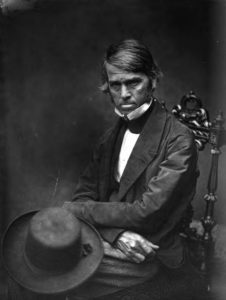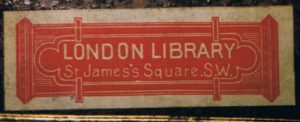
The London Library is one of the world’s largest independent lending libraries, and one of the UK’s leading literary institutions. It was founded in 1841 on the initiative of Thomas Carlyle, who was dissatisfied with some of the policies at the British Museum Library. It is located at 14 St. James’s Square, in the St James’s area of the City of Westminster, London, which has been its home since 1845. Membership is open to all, on payment of an annual subscription; and life and corporate memberships are also available. As of March 2015 the Library had 6,708 members.
T. S. Eliot, a long-serving President of the Library, argued in 1952 in an address to members that, “whatever social changes come about, the disappearance of the London Library would be a disaster to civilisation”.

History
The chief instigator in the Library’s foundation was Thomas Carlyle. He had become frustrated by the facilities available at the British Museum Library, where he was often unable to find a seat (obliging him to perch on ladders), where he complained that the enforced close confinement with his fellow readers gave him a “museum headache”, where the books were unavailable for loan, and where he found the library’s collections of pamphlets and other material relating to the French Revolution and English Civil Wars inadequately catalogued. In particular, he developed an antipathy for the Keeper of Printed Books, Anthony Panizzi (despite the fact that Panizzi had allowed him many privileges not granted to other readers), and criticised him, as the “respectable Sub-Librarian”, in a footnote to an article published in the Westminster Review. Carlyle’s eventual solution, with the support of a number of influential friends, was to call for the establishment of a private subscription library from which books could be borrowed.
The Earl of Clarendon was the Library’s first President, William Makepeace Thackeray its first auditor, and William Gladstone and Sir Edward Bunbury sat on the first committee. The Belgian freedom fighter and former Louvain librarian Sylvain Van de Weyer was a vice-president from 1848 to 1874. (Van de Weyer’s father-in-law Joshua Bates was a founder of the Boston Public Library in 1852.)

A vigorous and long-serving presence in later Victorian times was Richard Monckton-Milnes, later Lord Houghton, a friend of Florence Nightingale. Dickens was among the founder members. In more recent times, Kenneth Clark and T. S. Eliot have been among the Library’s presidents, and Sir Harold Nicolson, Sir Rupert Hart-Davis and the Hon Michael Astor have been Chairmen.
(Sir) Charles Hagberg Wright, who served as Secretary and Librarian from 1893 to 1940, is remembered as “the real architect of the London Library as it is today”. He oversaw the rebuilding of its premises in the 1890s, the re-cataloguing and rearrangement of its collections under its own unique classification system, and the publication of its catalogue in 1903, with a second edition in 1913–14 and later supplements.
Collections
The Library’s collections, which range from the 16th century to the present day, are strong within the fields of literature, fiction, fine and applied art, architecture, history, biography, philosophy, religion, topography, and travel. The social sciences are more lightly covered. Pure and natural sciences, technology, medicine and law are not within the library’s purview, although it has some books in all of those fields; books on their histories are normally acquired. Periodicals and annuals on a wide range of subjects are also held in the collections. Special collections include subjects of hunting, field sports, Rubaiyat of Omar Khayyam, and of Jewish interest.

In 1944, the Library lost some 16,000 volumes to bomb damage, and in 1970 its few incunabula were sold. With those exceptions, it has (apart from some duplicates) retained all items acquired since its foundation. The Library now holds more than one million items, and each year, it acquires approximately 8,000 new books and periodicals. 97% of the collection is available for loan, either on-site or through the post. It is the largest lending library in Europe.
It is a central tenet of the Library that, as books are never entirely superseded, and therefore never redundant, the collections should not be weeded of material merely because it is old, idiosyncratic or unfashionable: except in the case of occasional duplicate volumes, almost nothing has ever been discarded from the Library shelves.
The Library also subscribes to many ejournals and other online databases. All post-1950 acquisitions are searchable on the on-line catalogue, and pre-1950 volumes are progressively being added as part of the Retrospective Cataloguing Project.
95% of the collection is housed on open shelves (the remaining 5% includes rare books held in secure storage). This open access policy – which contrasts with that in many other large libraries, including the British Library – is greatly valued by members. Colin Wilson remembered his first visit to the library in the mid 1960s: “I have always had an obsession about books, and in this place I felt like a sex maniac in the middle of a harem”.
Be the first to comment